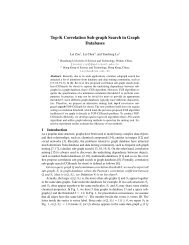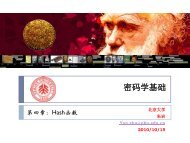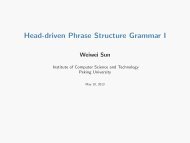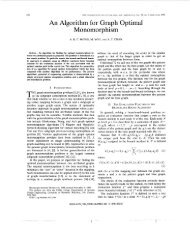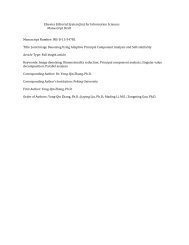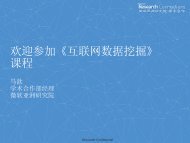PDF (1MB) - QUT ePrints
PDF (1MB) - QUT ePrints
PDF (1MB) - QUT ePrints
You also want an ePaper? Increase the reach of your titles
YUMPU automatically turns print PDFs into web optimized ePapers that Google loves.
38 · Alsayed Algergawy et al.<br />
large amounts of data. However, no evaluation work has been done considering a tradingoff<br />
between the two performance aspects.<br />
Finally, clustering XML data is useful in numerous applications. Table II shows that<br />
some prototypes have been developed and implemented for specific XML applications,<br />
such as XClust for DTDs integration and S-GRACE for XML query processing, while<br />
other prototypes have been developed for generic applications, such as XMine and XCLS<br />
for XML management in general.<br />
7. SUMMARY AND FUTURE DIRECTIONS<br />
Clustering XML data is a basic problem in many data application domains such as Bioinformatics,<br />
XML information retrieval, XML data integration, Web mining, and XML query<br />
processing. In this paper, we conducted a survey about XML data clustering methodologies<br />
and implementations. In particular, we proposed a classification scheme for these<br />
methodologies based on three major criteria: the type of clustered data (clustering either<br />
XML documents or XML schemas), the used similarity measure approach (either the tree<br />
similarity-based approach or the vector-based approach), and the used clustering algorithm.<br />
As well as, in order to base the comparison between their implementations, we proposed a<br />
generic clustering framework.<br />
In this paper, we devised the main current approaches for clustering XML data relying on<br />
similarity measures. The discussion also pointed out new research trends that are currently<br />
under investigation. In the remainder we sum up interesting research issues that still deserve<br />
attention from the research community classified according to four main directions:<br />
Semantics, performance, trade-off between clustering quality and clustering scalability,<br />
and application context directions.<br />
—Semantics. More semantic information should be integrated in clustering techniques in<br />
order to improve the quality of the generated clusters. Examples of semantic information<br />
are: Schema information that can be associated with documents or extracted from<br />
a set of documents; Ontologies and Thesauri, that can be exploited to identify similar<br />
concepts; Domain knowledge, that can used within a specific context to identify as<br />
similar concepts that in general are retained different (for example, usually papers in<br />
proceedings are considered different from journal papers, however a paper in the VLDB<br />
proceedings has the same relevance as a paper in an important journal). The semantics<br />
of the data to be clustered can also be exploited for the selection of the measure to be<br />
employed. Indeed, clustering approaches mainly rely on well-known fundamental measures<br />
(e.g., tree edit distance, cosine and Manhattan distances) that are general purpose<br />
and cannot be easily adapted to the characteristics of data. A top-down or bottom-up<br />
strategy can be followed for the specification of these kinds of functions. Following the<br />
top-down strategy, a user interface can be developed offering the user a set of buildingblocks<br />
similarity measures (including the fundamental ones) that can be applied on different<br />
parts of XML data, and users can compose these measures in order to obtain a<br />
new one that is specific for their needs. The user interface shall offer the possibility<br />
to compare the effectiveness of different measures and choose the one that best suits<br />
their needs. In this strategy, the user is in charge of specifying the measure to be used<br />
for clustering. In the context of approximate retrieval of XML documents, the multisimilarity<br />
system arHex [Sanz et al. 2006] has been proposed. Users can specify and<br />
compose their own similarity measures and compare the retrieved results depending on<br />
ACM Computing Surveys, Vol. , No. , 2009.



